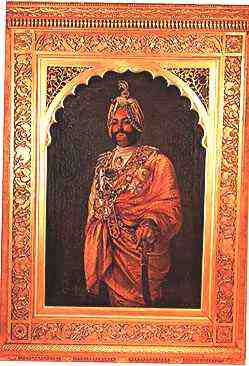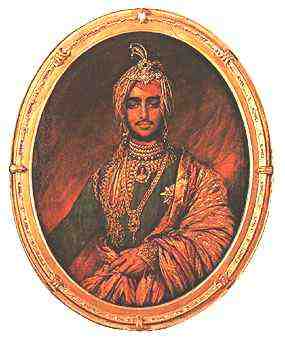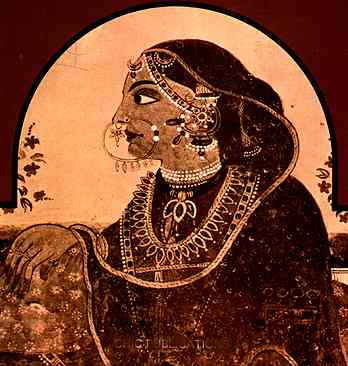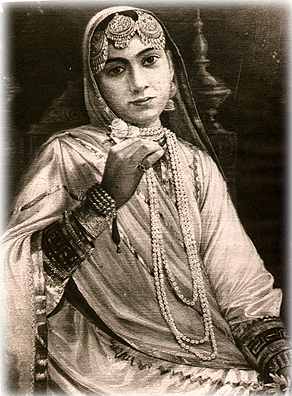
Of the Maharaja' s children by his first marriage, Victor married Lady Anne Coventry in 1892 and died without issue in 1918. Frederick died unmarried in 1928; he was a popular Norfolk squire and an enthusiastic local historian. He lived at Blo Norton Hall. Bamba married Dr Sutherland, who was at one time in charge of the Lahore Medical School. Bamba died in Lahore, without issue in 1957. Of Catherine and Sophia, little information can be found, except that neither had children, and Sophia died in 1948.
The Maharaja's second wife, Ada died in 1930. As for the children of the second marriage: Ada married M. Villement and died without issue in 1926, having committed suicide. Paulina married Lieut. Terry and was also childless.
Thus, so far as the record shows, there are no living direct descendants of the Maharaja Duleep Singh.



Reproduced is the profile of Maharani Jind Kaur, the wife of Maharaja Ranjit Singh, popularly known as 'Rani Jindan'.
This painting has been taken from the wall of an old Haveli of Sandhanwalia Sardars of Raia Sansi in Amritsar district. The wall painting is a fine adaptation of some miniature. The colours, now somewhat faded, were brilliantly laid on the drawing of the face, and shows the Maharani, perhaps, during the early phase of her marriage. She is adorned almost like a bride, with the nose-ring, the kanfuts, the necklaces, the bazuband on her arms and the rings on her fingers.

The big eyed queen became regent for her young son Dalip Singh, when he was made Maharaja after the death of his foster-brother, Maharaia Sher Singh.
Rani Jindan, a woman of beauty, from a modest household, whom Maharaja Ranjit Singh married late in his life, rose to be a heroine.
She resisted the efforts of the British to annex Punjab for some time. She came out of held durbar with the chiefs of the army, daily took counsel with the nobles, and conducted the State with uncommon common sense, in some of the most difficult situations facing the kingdom.
Of course, being one of the few daring women in the land, she was distrusted by her own folk and despised by the British. Some of them, however, praised her as "more than a man". Henry Lawrence, the Resident appointed by the British, contrived through various maneuvers to put her out of the way in jail in Shaikhupura, near Lahore. The dethroned Dalip Singh after some time, sending him first to the fort of Fatehgarh, in Uttar Pradesh, then to London in the care of a Scot tutor named Dr. Login.
Maharani Jindan was removed from Shaikhupura Fort to a fort of Chunnar, in Uttar Pradesh. She managed to escape from jail. After an arduous journey to Nepal, she got asylum from the Prime Minister Jung Bahadur in spite of the objections of the British Resident in Nepal. She patiently bore her exile, built a Gurdwara and resigned herself to lead the life of a good Sikh woman.

Still longing to see her son, she sent messages to Dalip Singh, who ultimately came to Calcutta to meet her.
Dalip Singh was already being treated shabbily by the Secretary of State for India, and the Viceroy would not increase his allowance though they had asked him to live like an English squire in a big country house, hunting, shooting and fishing.
Maharani Jindan died in 1863, believing that the kingdom of Punjab would still be restored to her son. Someone has said that she was more sinned against than sinning. This is the best epitaph for this tragic heroine of Punjab.